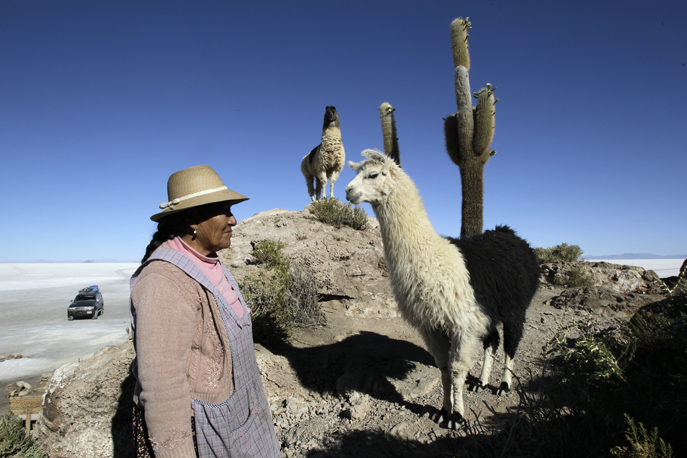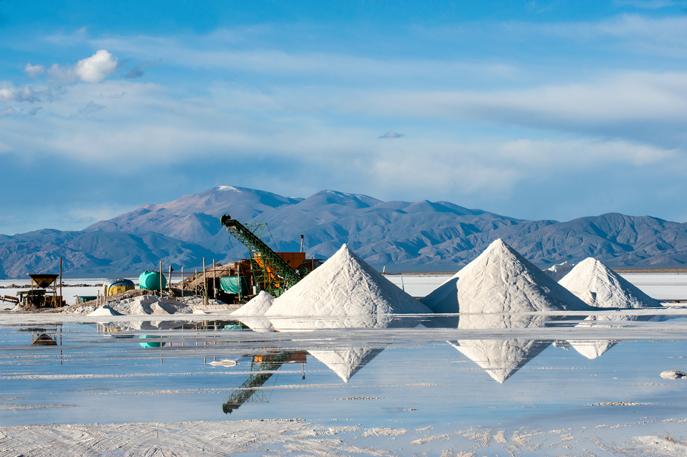Caroline Palmer reports on how the country with the world's biggest reserves is seeking to address concerns about the critical metal’s environmental and social impacts from indigenous and green groups – and car companies like VW and BMW, which are mainly sourcing from Australia
In April the people of Chile will get the chance to choose the 155 representatives who will write the country’s new constitution. The vote represents a peaceful resolution to 2019’s unrest, which saw more than a million protesters take to the streets, angry at the country’s inequalities.
For Cristina Dorador, a biologist at the University of Antofagasta in Chile, who studies microbial life in the Atacama desert, it will offer the opportunity to push urgent environmental issues to the top of the agenda. She has long been a critic of the way the government has managed its resources, in particular those that lie beneath the Atacama’s spectacular salt flats in the north of the country. This is not only where some of the richest deposits of lithium in the world are found, but they are nesting and breeding sites for the region’s rare breeds of flamingos.
“I have decided to stand as a candidate for the constitutional convention because I want to put the scientific point of view. I want the science around environmental protection to be a part of any decision-making in the country,” Dorador says.
Chile, Argentina and Bolivia make up South America’s 'lithium triangle' holding more than 75% of the world’s lithium reserves
Chile is a critical player in the global drive to reduce transport emissions through a shift to electric vehicles, powered by lithium-ion batteries.
Chile, Argentina and Bolivia make up South America’s “lithium triangle”, and together hold more than 75% of the world’s lithium reserves beneath their salt flats, although Australia, which holds 18.1% of reserves, surpassed Chile in 2018 to become the largest producer by metric ton, according to BP’s Statistical Review of World Energy.
In a report last year, the World Bank forecast that the production of key minerals, including lithium, would need to increase by nearly 500% by 2050 to provide components for critical clean energy technologies.

While global lithium supply and demand at the end of last year was nearly even, depressed by Covid-19, according to data from Benchmark Mineral Intelligence, by 2025 demand is expected to outstrip supply by nearly 228,000 tonnes, pushing up prices, and pressure on countries with reserves to exploit them.
If unsustainably produced, could lithium become a resource curse, in the same way as oil and gas has been to many developing countries?
Dorador points to the unique biodiversity that exists in the brine, from which the lithium is extracted, and what she says is the governmental sleight of hand to downplay the consequences of using water in a desert region that is one of the driest places on Earth.
Above all, the mining industry must develop in a way that protects and respects the environment
“Under environmental laws the brine is considered a mineral, not water, even though it is water with salt. So, when the government says that only 3% of water is used in mining, they are only referring to fresh water.”
Juan Carlos Jobet, Chile’s minister of energy, accepted in an interview during the Reuters Next conference in January that water was “a challenge” for the lithium industry in Chile, but said it would be addressed as part of a lithium roadmap, which is being developed based on a consultation with more than 100 representatives from the sector.
The government says it wants to lay down a timetable and framework to create "integrated and intelligent mining” that is both green and safe. Chile’s minister of science, technology, knowledge and innovation, Andrés Couve, has been quoted as saying: "Above all, the mining industry must develop in a way that protects and respects the environment."

The two big mining companies that have licences to operate in Atacama, Chile’s SQM and U.S. based Albemarle, deny that the 2,000 litres of saltwater that are extracted every second to produce lithium are affecting freshwater levels. Eric Norris, who runs Albemarle’s lithium business, told the same Reuters event that the company’s operations were not threatening water supplies or ecosystems.
On the contrary, he says, “the environmental impact is very positive. “Each kilogram of lithium that is produced enables orders of magnitudes of avoided greenhouse gas emissions … through green miles driven by electric vehicles.”
George Miller, an analyst at Benchmark Mineral Intelligence, believes the mining companies have made “excellent” efforts to reduce water usage and to make the extraction as efficient as possible, including SQM’s move to set up a website where its water usage can be tracked in the wake of a number of legal disputes between the miners, the regulator and indigenous and environmental groups.
The water is evaporating all the time. Even without mining it will only last another 100 to 200 years
Dorador disagrees. “We are lacking investment in scientific data on exactly what the impacts of mining are. If a mining company proposes a project, they bring in their own consultants to look at the impact. There is no government data. If any problems are identified they are allowed to mitigate them by, for instance, building a road or a school. This is already a terminal ecosystem. The water is evaporating all the time. Even without mining it will only last another 100 to 200 years.”
In Bolivia, political upheavals, a wetter climate and local opposition have all acted as barriers to exploiting its considerable lithium deposits.
But in Argentina, which ranks fourth in production behind China, the lithium industry is in the grip of a “white gold rush”, says Richard Kent, a researcher on business and human rights at Amnesty International, which has been documenting violations of the human rights of indigenous peoples living near lithium mines in Argentina. In a 2019 report, the NGO said licences for lithium exploration in the Salinas Grandes salt flats had been granted without proper consultation with indigenous communities affected.

Farn (Fundación Ambiente y Recursos Naturales), an Argentinian NGO, says: “There are now around 46 different projects of lithium extraction at different stages [in Argentina]. However, little consideration has been given to … [impacts on] human rights and the social and environmental sustainability of the projects.”
This conflict between cleaner forms of transport and the consequences of lithium mining is causing concern in Europe and the U.S., where policymakers are becoming nervous about being reliant on imports of such important minerals and seek the security of being able to produce their own.
In February, U.S. President Joe Biden signed an executive order to review the supply chains of four key products, including batteries, used in electric cars, to ensure their security (see Biden’s EV plan puts charge through U.S. auto industry).
Pollution from a Nevada mine has been blamed for fish deaths downstream
The U.S. isn't immune from the environmental and human rights consequences of developing its own mines. A Nevada rancher is reported to be suing regulators over the approval of a lithium mine on federal land that he says would violate environmental laws and threaten fish and wildlife. However, there are also reports of local tribal groups welcoming the prospect of much-needed jobs.
Tesla chief executive Elon Musk told shareholders in September that he had secured the rights to mine his own lithium in Nevada.
In Nevada the lithium is extracted from rock using more traditional mining techniques, but toxic chemicals are used in its extraction. Pollution from a Nevada mine has been blamed for fish deaths downstream and in 2016 a similar incident devastated fishing stocks in Tibet.

Car companies, meanwhile, are keen to show that their commitment to the environment and human rights spans the entire supply chain of their vehicles. BMW, for example, has commissioned two U.S. universities to conduct a scientific analysis of water consumption in the lithium-extraction process.
The carmaker already sources lithium directly from two mines in Australia, where it is produced from ore mining rather than brine water, via the Chinese lithium supplier Ganfeng.
It says it may also enter into contracts with other lithium producers, provided they “are fully compliant with our stringent sustainability standards”.
“Water consumption will be a further focal point in this context,” a BMW spokesperson says. “It has not yet been clarified what effects the mining of lithium actually has in individual regions in South America. This is why we have commissioned the study.” Its results are expected early next year.
How many electric vehicles do we really need? People are suffering
Meanwhile Volkswagen, which sources from Ganfeng in Australia as well as Chile, sent a fact-finding mission to Chile in March to “gain a better understanding of how living conditions in the Atacama desert are changing in order to analyse how end users like Volkswagen can contribute to sustainable conditions for lithium production in Chile”, a spokesman said.
“The situation in Australia is different as lithium is mined from hard rock with less water consumption and Australia has comparatively strict mining environmental laws and policies.”
Some question whether the environmental cost of lithium extraction is too high to be sustained at scale. Jonathan Stacey, an ecologist at mining consultancy Levin Sources, says: “We are dealing with climate change issues and an emissions crisis. Is there enough lithium to take us through this transition to another technology such as hydrogen, with less environmental impact?”
Dorador stresses the importance of transparency about the social and environmental impact of lithium extraction. “It is also important to look at wider policy. How many electric vehicles do we really need? People are suffering.”
Caroline Palmer is a freelance journalist specialising in business, health, sustainability and the artisan economy. She has worked for the Financial Times, The Guardian and The Observer.
This article is part of the in-depth Sustainable Transport briefing. See also:
Rethinking the commute to work post Covid-19
Biden’s EV plan puts charge through U.S. auto industry
UK firms lend heft to getting electric vehicle revolution on the road
From cul-de-sac to second life for redundant car batteries
Will green hydrogen fulfill high hopes for trucking and shipping emissions?
Sustainable aviation fuels get powerful boost from pandemic
Indonesian rush to biodiesel raises fears about spike in deforestation risk


